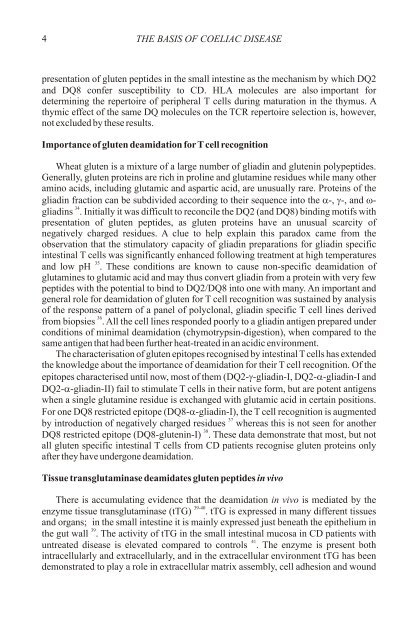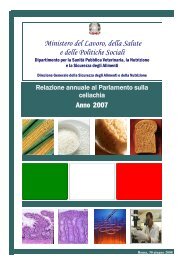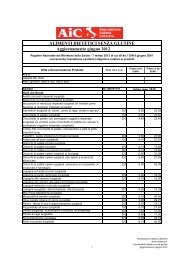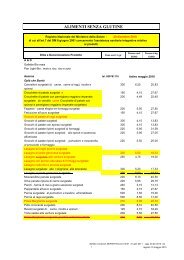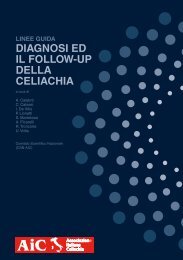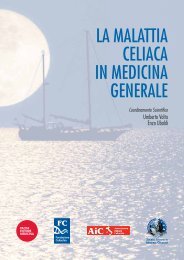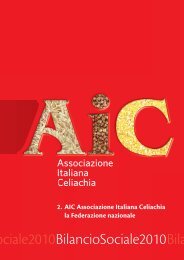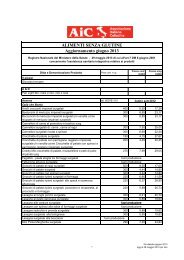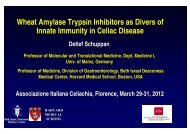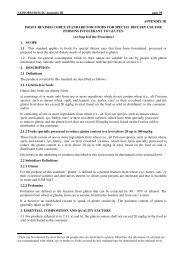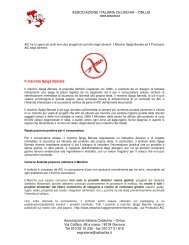primary prevention of coeliac disease - Associazione Italiana ...
primary prevention of coeliac disease - Associazione Italiana ...
primary prevention of coeliac disease - Associazione Italiana ...
Create successful ePaper yourself
Turn your PDF publications into a flip-book with our unique Google optimized e-Paper software.
4 THE BASIS OF COELIAC DISEASE<br />
1<br />
presentation <strong>of</strong> gluten peptides in the small intestine as the mechanism by which DQ2<br />
1<br />
and DQ8 confer susceptibility to CD. HLA molecules are also important for<br />
determining the repertoire <strong>of</strong> peripheral T cells during maturation in the thymus. A<br />
thymic effect <strong>of</strong> the same DQ molecules on the TCR repertoire selection is, however,<br />
not excluded by these results.<br />
Importance <strong>of</strong> gluten deamidation for T cell recognition<br />
Wheat gluten is a mixture <strong>of</strong> a large number <strong>of</strong> gliadin and glutenin polypeptides.<br />
Generally, gluten proteins are rich in proline and glutamine residues while many other<br />
amino acids, including glutamic and aspartic acid, are unusually rare. Proteins <strong>of</strong> the<br />
gliadin fraction can be subdivided according to their sequence into the a-, g-, and w-<br />
34<br />
gliadins . Initially it was difficult to reconcile the DQ2 (and DQ8) binding motifs with<br />
presentation <strong>of</strong> gluten peptides, as gluten proteins have an unusual scarcity <strong>of</strong><br />
negatively charged residues. A clue to help explain this paradox came from the<br />
observation that the stimulatory capacity <strong>of</strong> gliadin preparations for gliadin specific<br />
intestinal T cells was significantly enhanced following treatment at high temperatures<br />
35<br />
and low pH . These conditions are known to cause non-specific deamidation <strong>of</strong><br />
glutamines to glutamic acid and may thus convert gliadin from a protein with very few<br />
peptides with the potential to bind to DQ2/DQ8 into one with many. An important and<br />
general role for deamidation <strong>of</strong> gluten for T cell recognition was sustained by analysis<br />
<strong>of</strong> the response pattern <strong>of</strong> a panel <strong>of</strong> polyclonal, gliadin specific T cell lines derived<br />
36<br />
from biopsies . All the cell lines responded poorly to a gliadin antigen prepared under<br />
conditions <strong>of</strong> minimal deamidation (chymotrypsin-digestion), when compared to the<br />
same antigen that had been further heat-treated in an acidic environment.<br />
The characterisation <strong>of</strong> gluten epitopes recognised by intestinal T cells has extended<br />
the knowledge about the importance <strong>of</strong> deamidation for their T cell recognition. Of the<br />
epitopes characterised until now, most <strong>of</strong> them (DQ2-g-gliadin-I, DQ2-a-gliadin-I and<br />
DQ2-a-gliadin-II) fail to stimulate T cells in their native form, but are potent antigens<br />
when a single glutamine residue is exchanged with glutamic acid in certain positions.<br />
For one DQ8 restricted epitope (DQ8-a-gliadin-I), the T cell recognition is augmented<br />
37<br />
by introduction <strong>of</strong> negatively charged residues whereas this is not seen for another<br />
38<br />
DQ8 restricted epitope (DQ8-glutenin-I) . These data demonstrate that most, but not<br />
all gluten specific intestinal T cells from CD patients recognise gluten proteins only<br />
after they have undergone deamidation.<br />
Tissue transglutaminase deamidates gluten peptides in vivo<br />
There is accumulating evidence that the deamidation in vivo is mediated by the<br />
39-40<br />
enzyme tissue transglutaminase (tTG) . tTG is expressed in many different tissues<br />
and organs; in the small intestine it is mainly expressed just beneath the epithelium in<br />
39<br />
the gut wall . The activity <strong>of</strong> tTG in the small intestinal mucosa in CD patients with<br />
41<br />
untreated <strong>disease</strong> is elevated compared to controls . The enzyme is present both<br />
intracellularly and extracellularly, and in the extracellular environment tTG has been<br />
demonstrated to play a role in extracellular matrix assembly, cell adhesion and wound


